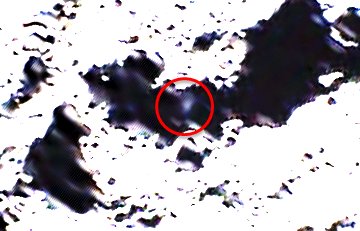| METEORS FROM HALLEY'S COMET: The Orionid meteor shower, caused by debris from Halley's comet, peaks this week. Forecasters expect dozens of meteors per hour during the dark hours before sunrise on Wednesday, Oct. 21st. Science@NASA has the full story. Orionid meteor galleries: 2006, 2008 ROCKET FUEL DUMP: A Centaur rocket caused a minor sensation on Sunday night, Oct. 18th, when it flew over Europe and dumped a load of excess propellant. "We saw it at 9:15 pm local time (1915 UT)," report Federico and Chiara Bellini of Bodio Lomnago, Italy. "It looked like a comet with a fan-shaped tail." They took this 30-second exposure using a Nikon D70s: 
"About 20 seconds later, a second object appeared." That was a US military weather satellite (DMSP F-18), which the Centaur booster had helped launch earlier in the evening from Vandenberg, Air Force Base in California. "And then," the Bellinis continue, "a big circular halo followed the two across the sky." The halo, shown here in a movie recorded by Jonas Förste of Jakobstad, Finland, was probably an expanding puff of gas emitted during an earlier firing of the Centaur. more images: from Marko Posavec of Koprivnica, Croatia; from Davide Trezzi of Varenna, Italy; from Vince Tuboly of Hegyhátsál, Hungary; from Quentin D. of le Havre, Normandy, France; from Feys Filip of the Sasteria public observatory, Crete LUNAR IMPACT PLUME: There was a plume after all. Observers on Earth had their doubts after LCROSS and its Centaur booster rocket hit the Moon on Friday, Oct. 9th. The twin lunar impacts failed to produce visible plumes of debris, prompting speculation that something had gone wrong. On the contrary, members of the LCROSS science team are now calling the experiment "a smashing success." Fifteen seconds after the Centaur hit the shadowy floor of crater Cabeus, the LCROSS spacecraft flying 600 km overhead took the following picture of a plume measuring 6 to 8 km wide: 
"There is a clear indication of a plume of vapor and fine debris," says LCROSS principal investigator Tony Colaprete of NASA/Ames. "The ejecta brightness appears to be at the low end of our predictions and this may be a clue to the properties of the material the Centaur hit." Nine cameras and spectrometers on LCROSS captured every phase of the Centaur's impact: the intial flash, the debris plume, and the creation of the Centaur's crater. "We are blown away by the data returned," says Colaprete. "The team is working hard on the analysis and the data appear to be of very high quality." But did the impact reveal any water at the bottom of Cabeus? The LCROSS team isn't ready to say yet. Combining their data with those of other observatories and analyzing the full dataset could take weeks. According to NASA, "any new information will undergo the normal scientific review process and will be released as soon as it is available." For more information, read NASA's Oct. 16th press release and browse the gallery of images.
Sept. 2009 Aurora Gallery
[previous Septembers: 2008, 2007, 2006, 2005, 2004, 2002, 2001]
Explore the Sunspot Cycle | 
